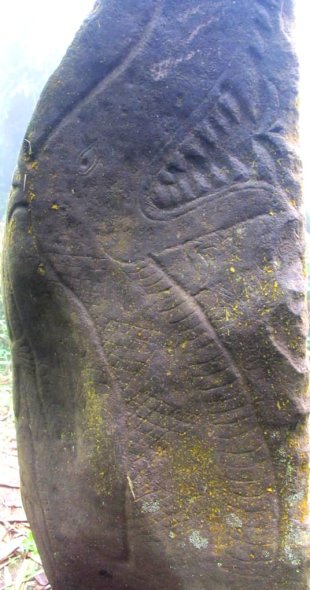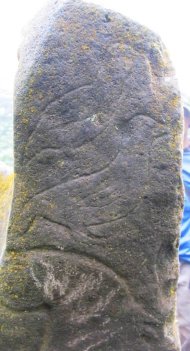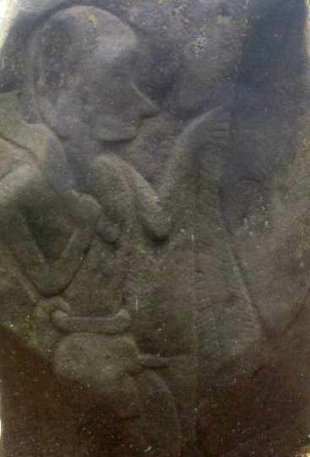Archaeologists Archaeology Society of Indonesia (MARI Archaeology) researching slate inlaid dragon on Jabranti village in Kuningan, West Java. "This stone is probably the only tangible legacy dragon in West Java," said archaeologist from the University of Indonesia, Ali Akbar, when contacted by phone, March 15, 2013.
 |
| Stone dragons. Photo: Ali Akbar |
Slate is located atop Mount Tilu, Banjaran Hamlet, Village Jabranti, District Karangkencana, Kuningan regency, West Java. Local residents have long been aware of the existence of this stone, but felt compelled to view the state of the site which lies on the border between West Java and Central Java. The site is regularly visited only by those who meditate or ngalap blessings, seeking pesugihan.
Upright stone carved dragon figure is estimated to be relics of prehistoric times. According to Ali, upright stone that comes from intact stones, according to the original stone without molded is a common feature of the prehistoric record. However, the picture in the stone carvings, especially pictorial dragon, not a characteristic of prehistoric societies.
So, from the time whether these relics come from? To answer that question Ali Akbar have a hunch. "There is a possibility that the relief is carved later," he said. The composition of the rock is estimated to have descended from the prehistoric period, the period of 500 BC. Later, carvings made by people from different times. Carving dragons probably derived from the ancient Sunda around 14-15 century AD.
Relics comprises two large stones arranged like a gate, welcoming people coming from the south. Before and after passing through the "gate", there are a lot of big rocks scattered about. Chances are there are certain patterns in the arrangement of these stones. Unfortunately, the observations can not be done because of the condition of the site covered in lush forests.
"There is a rock that scratched goresannya form images," said Ali. When noted, these images resemble the shape of a dragon. Ali assumed the picture was drawn dragon as half of the body and has a crest on the head like a dragon.
 "The dragon is carved in the image of a dragon in eastern cultures for intangible cheerful," he said. Ali Akbar explained that there are two kinds of dragons known in culture. In eastern cultures, the dragon is a symbol of goodness, whereas in western culture, the dragon is a symbol of violent crime and evil.
"The dragon is carved in the image of a dragon in eastern cultures for intangible cheerful," he said. Ali Akbar explained that there are two kinds of dragons known in culture. In eastern cultures, the dragon is a symbol of goodness, whereas in western culture, the dragon is a symbol of violent crime and evil.If the picture was actually a dragon, then the slate is the first dragon-shaped relics found in West Java. In contrast to East Java region of strong Hindu influence, shape dragon never known in West Java.
Dragon is also not known in ancient Sundanese culture. "Sundanese culture more familiar with the snake as a symbol of fertility and carrier blessings," said Ali. The images can also be seen as a huge serpent crown, because no images of the foot as it is commonly found in the embodiment dragon.
 On one of the stone is also engraved human figure haired bald. The man holding the tail of a dragon while holding guns. The weapons are similar to the motif found in Sukuh, Central Java. These characteristics reinforce allegations regarding age relief, allegedly carved in the ancient Sunda, where Majapahit still prevail.
On one of the stone is also engraved human figure haired bald. The man holding the tail of a dragon while holding guns. The weapons are similar to the motif found in Sukuh, Central Java. These characteristics reinforce allegations regarding age relief, allegedly carved in the ancient Sunda, where Majapahit still prevail.One side of the stone is carved with images allegedly triangle symbol mountains and rooftops. Two people pictured planting, the sculptures are thinner than before. "This triangle can also be used to describe the mountain erupted," he said.
He explained the way to the location of the slate was not easy. It took a six-hour drive from Jakarta to arrive at the Kuningan. Of Brass, the group moved Banjaran village, the last settlement at the foot of the mountain.
From the village of Banjaran, proceed on foot for three to five hours through the forest with dense vegetation. "A lot of brambles and slugs, no way," said Ali.
The expedition started from the report on the website mariarkeologi, an organization that aims to unearth archeology to the general public. "Archaeologists should be suspicious if there are reports of people on the slate or a sacred object, because it is possible archaeological remains," said Ali Akbar.
Research is still going to continue to uncover the mystery surrounding the existence of this stone. The team of archaeologists has taken soil samples to be tested in the laboratory. Next, they plan to make a mold the shape of the original stone relics that can be enjoyed by the wider community. "What's real hard to reach and vulnerable to landslides so difficult to use a tourist location," said Ali.
http://id.berita.yahoo.com/arkeolog-meneliti-situs-naga-jabranti-093452901.html

0 comments:
Post a Comment